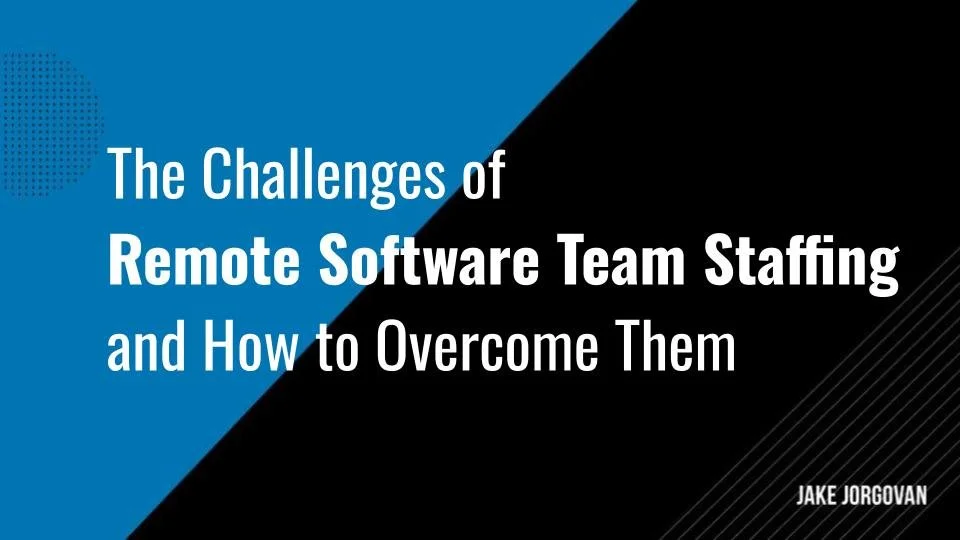The Challenges of Remote Software Team Staffing and How to Overcome Them
The rise of remote work has opened a new frontier for software development teams. This shift toward a digital workspace brings a unique set of challenges that can make or break the success of projects and the well-being of teams.
Navigating these waters requires a blend of innovative strategies and a keen understanding of the nuances of remote collaboration.
In this article, we delve into the intricacies of remote software team staffing, unearthing the common hurdles and providing actionable insights to turn these challenges into opportunities for growth and efficiency.
So, keep reading below:
1. Finding qualified talent in remote locations
This can be one of your greatest hurdles to overcome – no pressure.
The remote nature of your work inherently limits your hiring potential to a smaller pool of candidates. Even more so if you're targeting specific technical skills or industry experience.
Besides, not having a local workforce makes locating top talent who meet all your criteria much more difficult. You may find yourself competing against companies that can offer prestigious jobs closer to population centers.
So, how do you expand your reach and attract the right people?
The key is to optimize your sourcing and recruitment tactics. We suggest posting job openings on remote-friendly job boards, virtual career fair platforms, and networking in online communities. Don't limit yourself to local candidates – look globally and consider asynchronous interviewing methods to talk to top talent anywhere.
Recruiting professional Preston Park has more insights:
2. Building trust and collaboration without in-person interactions
Establishing strong working relationships is challenging in any environment, but especially so when teammates never meet face-to-face. Without the usual watercooler interactions, lunch meetings, or casual conference conversations, it's difficult to get to know colleagues on a personal level and see the relaxed, authentic sides of their personalities.
Collaboration becomes an issue as well, as spontaneous idea-sharing, brainstorming, and strategizing are much less likely without that in-person synergy. It's harder to read social cues over video alone and sense group dynamics. Informal learning also occurs less organically without casual over-the-shoulder mentoring and the light oversight in a shared workspace.
Overcoming these hurdles requires dedicated efforts to foster strong social ties remotely.
We recommend:
Encouraging video calls and online community-building activities beyond work topics to humanize your colleagues beyond profiles on a screen.
Making time for fun virtual team outings and games helps relieve stress and strengthen bonds in a low-pressure setting.
Sharing behind-the-scenes company details to deepen your remote employees’ investment and care for organizational success.
3. Ensuring effective communication across time zones
With employees in various hemispheres, keeping everyone on the same page while juggling differing schedules can seem near impossible. It's all too easy for messages to get missed, priorities to get misaligned, and meetings to end up planned during unworkable hours for some.
Throw in language and cultural barriers, too, for truly global teams, and misunderstandings ramp up easily. Key talks risk losing nuanced context over stale messages.
For effective communication and collaboration, our best advice is to:
Optimize processes using asynchronous methods like written docs, comments, and messaging.
Schedule intentional sync-ups at overlapping times to align priorities.
Ensure all critical discussions are documented and crystal clear for later reference.
Equip your team with collaboration tools like task management, file sharing, and video conferencing to stay linked seamlessly across geographies.
4. Providing the tools and infrastructure for remote work
Having your team scattered means they need laptops, high-speed internet, project management portals, and more just to do their jobs daily from makeshift home setups. Without company-provided equipment and platforms, though, productivity will tank as workers make do with unstable Wi-Fi, restrictive devices, or incomplete project access.
Morale also takes a hit if colleagues feel undersupplied or abandoned to poorly-constructed DIY workspaces. Technical and ergonomic issues will inevitably cause frustration and health problems without office-level support.
To ensure optimal remote work conditions, our experience shows these proactive steps are best:
Prioritize asynchronous communication methods that allow flexible participation.
Leverage task and document management tools, comments, and messaging for information to flow seamlessly across locations.
Standardize conference solutions that all team members can access reliably from any device for critical synchronized discussions.
If you have the budget, you can also:
Invest in top-tier laptops, dual monitors, ergonomic chairs, and security essentials for each employee's dedicated remote office space.
Offer stipends to cover high-speed internet and other costs of establishing a productive setup at home.
Provide 24/7 IT assistance and training to resolve connectivity troubles quickly before they disrupt workflow.
Pro tip: Your commitment to resources will galvanize their dedication in return, thus skyrocketing your ROI.
5. Data security and privacy concerns
As a distributed organization, your crown jewels of client data are intellectual property and financial information. These are potentially more vulnerable from dispersed devices outside the protections of an enterprise network. Laptops are lost, home Wi-Fis is compromised, and unauthorized access is a larger risk without physical security protocols and IT security governance over remote employee endpoints.
Warning: A data breach or privacy exposure could instantly destroy your brand's reputation and client trust. It could also result in steep fines for non-compliance with regulations like GDPR. These sorts of threats understandably leave business leaders and customers feeling anxious about the security of a remote setup.
We suggest taking these specific actions to help allay security concerns:
Enforce multifactor authentication and access controls for all critical platforms.
Train staff continuously on password management, device usage policies and detecting phishing attempts.
Conduct regular audits of access privileges and security hygiene.
Purchase cyber liability insurance and consult top security professionals to stay protected with remote perimeter defenses that are just as robust as on-site solutions.
Keep transparency around your protocols to reassure skeptics that data stays as guarded off-site as on.
6. Monitoring productivity and performance management remotely
Leading geographically distributed teams requires reinventing how supervisors evaluate work without direct observation. It's tougher to gauge focus, priorities, and workflow in an environment without over-the-shoulder oversight. Micromanaging is also a surefire way to tank the trust and satisfaction of independent remote professionals.
At the same time, lapses can more easily fly under the radar without the physical proximity alerting managers to issues. Measuring impact and continuous improvement becomes less clear-cut if output metrics and reviews are not carefully reimagined for remote scenarios.
To solve this challenge, take these impactful steps:
Agree upfront on transparent goals, key results, and expectations. These should be customized for individual roles and assessable remotely.
Check in frequently for guidance and course corrections, not criticism.
Leverage project management and reporting tools. Avoid over-reliance on quantitative stats alone - qualitative check-ins and feedback exchange are also essential for calibrating well-being, engagement, and high-level performance.
Consider the outcome over hours worked when evaluating your remote staff.
7. Complying with employment laws and regulations in different locations
When staff resides internationally, just one missed detail in legal compliance like payroll, benefits administration, or labor rules in a foreign country can result in hefty fines or revoked operating permission. The regulatory minefield expands exponentially compared to a single domestic market.
Keeping on top of variations in jurisdiction-specific guidelines for issues like overtime standards, minimum wage, time off allotment, immigration paperwork, tax withholding, and more is a full-time job in itself. Misclassifying even one individual worker or filing incorrect reports puts everything at risk.
Besides, terminating a remote employee can be extremely difficult.
To avoid this issue, take these important compliance steps:
Consult expert local advisors intimately familiar with each staff location's statutes. Have them review employment contracts and help register necessary business entities like subsidiaries. Leverage their counsel to issue legally vetted policies and correctly classify all hires.
Consider using an international PEO to simplify global HR administration according to their jurisdiction.
Instead of hiring your team members as employees, consider collaborating with them as independent workers. But still, remember to draft contracts to keep everything legal.
Wrapping Up
Assembling and nurturing a remote software team is like navigating a complex digital ecosystem. Each challenge, from sourcing talent globally to fostering a culture of trust and collaboration, demands a thoughtful approach and a dedication to adaptability.
By embracing these strategies, you can build resilient, high-performing teams that thrive in the remote work paradigm.
The future of software development is undoubtedly distributed, and with the right tools and mindset, you can unlock unprecedented levels of innovation and productivity in this new era.
























